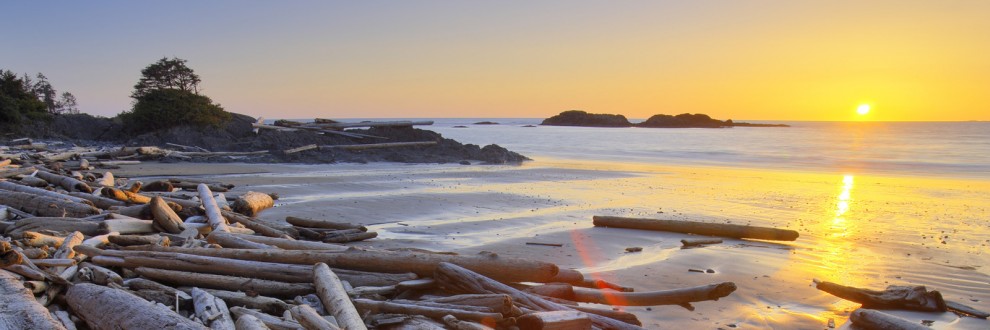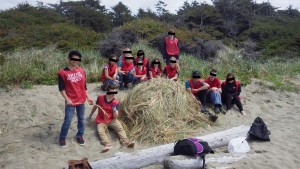We arrived early, pulling into Wickaninnish Beach parking lot E, and got out the equipment: a blue tote bin filled with red volunteer vests and old gardening gloves. I readied myself to teach, again, shaking out the dead head I get in the early morning. I breathed deep the fresh salty air. The trees were a lush green. Today was a good day…
The field trip was set to start in about fifteen minutes, at 0900hrs. I re-read the introduction of my lesson plan, and organized the handouts I’d give. The Pac Rim Resource Conservation manager, Mark, showed up to sign-off on the volunteer activity. We chatted about the state of Wick Beach, and the future of the Parks Canada volunteer program. The dune restoration program may be scrapped due to budget cuts. So my lesson may never again see the light of day. So I vowed to make it a good one.
The van arrived, and students fell out of it like a clown car at the circus. 13 in total, they chatted and woke up with the fresh air.
“Goodmorning everyone,” I broke in tersely, “my name is Adam. I will be your guide, today, as we explore Wickaninnish Beach. I have two activities planned for you, today; namely a nature hike — where we will identify plants — and an invasive grass pulling activity. Who here has been to Wick Beach, before?”
Everyone raised their hand. So this would be nothing new, for them. Damn. Well, let’s hope the plant interpretation activity sparks some interest, I thought to myself.
We went around the circle and identified ourselves and our favorite animal or plant. Most students said animals (some very bizarre, like a porpoise), and then one girl thought for a while and finally said “I like trees”. It was good to get some light-hearted laughs out of everyone, and I tried to keep the intro chat just as fun.
We moved to the beach, and perhaps the wind woke them all up, but they listened intently as I told them the story of Chief Wickaninnish, and the insult by Jonathan Thorn, and the raiding party and massacre of all of Thorn’s men — and the huge explosion of 9000 lbs of gunpowder that “blew the ship to atoms”. They were enthralled, and only two students had heard the story before (they were members of the local First Nations).
After more talk about the beach through the ages (including the finding of the unexploded mortar round from WWII only a couple years earlier) I explained the interpretation activity and handed out the plant identification sheets to the students. They seemed really into the idea. In small groups, mostly partners, they wandered up the beach and through the dune sites. In fact, the activity was totally successful — even too successful. All the groups identified almost all the plants on the sheet. The game was a tie. So we modified it, and I declared the first group to find the endangered pink sand verbena victorious!

The Pink Sand Verbena
We then stopped and reviewed the plants, and the difficulties the students had — which was only finding one or two endangered species — and then we walked back to the grass pulling site and had lunch. I explained some of the optional modules on my lesson plan, but the students weren’t very interested. In the future I would leave that part out unless asked. However, the Parks Canada Tide Books were interesting to a lot of the students — they raced to find the day’s high tides and low tides.
Mike reviewed the differences between the invasive and native grasses, and the students, with full stomachs and under a beautifully radiant, hot sun, begrudgingly started the grass-pulling activity. I made small notes and revisions to my plan.
When they had finished, we still had about half an hour of time, and some of the students suggested that we play a game called “Stealing Sticks”. I loved the idea, and appealed to Kevin and Erin, the Ucluelet Secondary teachers, and they totally agreed. Awesome and easy going.
I lead a group of about 8 of us back up to the smaller dune site. It was like a perfect arena for the game. We planted the sticks (5 per team) at either end, and I delegated teams, and we began to play. The concept is that you have to cross over the half line into enemy territory, and run and grab a stick and bring it back to your sticks. At the end of the game, the team with the most sticks wins. When we crossed over into enemy territory, we had to either run or hide — or else be tagged and sent back to our zone. It was stupendous fun, running barefoot in the hot sand. Mind you, it was incredibly hard to maneuver quickly. I’m really quite quick in similar games, like my aforementioned paintball, or even dodgeball. But on the hot, soft sand, all quickness was slowed. Still, my team started the game with a near crushing defeat of the enemy team. We had all but one of their sticks. But then something happened. I don’t know what, but suddenly three of their team made it to our sticks, and ran back without getting tagged! The tide shifted, as it were, and suddenly we were deep in the red. I ran and hid behind a low, grassy dune, and I heard the enemy team calling out “where is he?!”, but they lost track of me and I ran in and grabbed another stick. Our team made a valiant effort, but one of our number was just walking around aimlessly kicking sand. In spite of our efforts, we lost to the underdogs. It was a great finish to an excellent first run of my lesson plan. And not only that, but I even got to incorporate some experiential and just plain old fun activities into the day!
A great success overall, and a great finish to my CFE.

